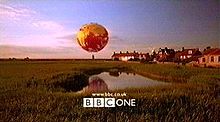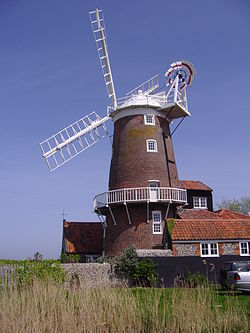- Cley Windmill
-
Cley Windmill
The mill in 2008Origin Mill name Cley Mill Mill location TG 0449 4404
52°57′16″N 1°02′34″E / 52.95444°N 1.04278°EOperator(s) Private Year built Early C19th Information Purpose Corn mill Type Tower mill Storeys Five storeys Number of sails Four sails Type of sails Double Patent sails Windshaft Cast iron Winding Fantail Fantail blades Eight blades Number of pairs of millstones Three pairs Cley Windmill is a grade II* listed[1] tower mill at Cley next the Sea, Norfolk, England which has been converted to residential accommodation.
Contents
History
Cley windmill was built in the early 19th century. It was not marked on William Faden's map of Norfolk published in 1797. The first mention was an advert in the Norfolk Chronicle of 26 June 1819, where the mill was for sale, described as "newly erected" and in the ownership of the Farthing family. The mill was not sold and remained the property of the Farthing family, until 1875, when Dorothy Farthing, the then owner, died. The mill was bought by the miller, Stephen Barnabas Burroughes. It was worked by the Burroughes family until c1912, when the business was transferred to their windmill at Holt.[2]
In 1921, the windmill was sold by the Burroughes Brothers to Mrs Sarah Maria Wilson for the sum of £350 and she had the mill converted to a holiday home.[2] The architect responsible for the conversion was Cecil Upcher.[3] The machinery was removed, with the gear wheels being cut in half and used as decoration within the mill.[4]
The mill was inherited by Lt Col Hubert Blount, in 1934. On 31 January 1953, the mill was flooded to a depth of at least 8 feet (2.44 m).[3] In 1960, Norfolk County Council and the Pilgrim Trust both made grants to enable the sails to be replaced., the council granting £500 and the trust granting £300 towards a total cost of £1,500.[5] The work was done by R Thompson & Son, the Alford, Lincolnshire millwrights. Further grants were received by Lt Col Blount from Norfolk County Council in 1963 and 1971.[2]
Lt Col Blount died on 1 February 1979 and the mill was inherited by Colonel Charles Blount,[2] of Andover, Hampshire.[3] The mill was offered for sale in May 1982, but did not sell. In 1983, planning permission and listed building consent was sought from North Norfolk District Council to turn the mill and complex into a guesthouse and self-catering units. This was granted, with the mill opening as a guesthouse on 27 April 1983.[2]
In 1986-87, the cap gallery, sails and fantail were renewed. Grants totalling £19,000 were given by English Heritage and Norfolk County Council towards an estimated cost of £45,000. The work was done by millwrights John Lawn and John Bond.[3] In December 2006 the windmill was put up for sale for the sum of £1,500,000.[6]
Description
For an explanation of the various items of machinery, see Mill machinery.Cley windmill is a five storey tower mill with a stage at second floor level, twenty feet above ground. It has a dome shaped cap with a gallery which was winded by an eight-bladed fantail, ten feet six inches in diameter. The cap is now fixed and unable to turn to wind. There are four double Patent sails with a span of 70 ft, carried on stocks 56 feet (17.07 m) long. The inner pair have eight bays of three shutters and the outer pair have nine bays of two shutters and one of three shutters. In 1819 the sails powered two pairs of French burr millstones, a flour mill and jumper but by 1876 this had been increased to 3 pairs of stones and a smut machine had been added.[2]
Millers
- John Farthing 1819-22
- John Lee 1822-48
- William Edward Powell 1848-50
- Lawrence Randall 1853-72
- Stephen Barnabas Burroughes 1875-1900
- Burroughes Bros 1900-12
Reference for above:-[2]
Public access
Cley windmill is open to the public as a guesthouse on a bed and breakfast basis.
Culture and media
 The BBC balloon over Cley Windmill
The BBC balloon over Cley Windmill
Cley windmill has become one of the enduring icons of North Norfolk. Its image has been used on everything from tea towels through to greetings cards, tins of biscuits and fudge to advertising between programs for the BBC. In October 1998 the BBC's world logo was replaced with a balloon seen flying over, initially, ten different locations in the UK, including Snowdon, the Forth Rail Bridge and Canary Wharf. Included as one of the locations was Cley Windmill. The films apparently cost £500,000 to make.
Cley windmill is licensed to hold wedding ceremonies.[7]
Cley windmill was owned by the grandfather and father of James Blunt, who spent time at the mill during his childhood.[8]
References
- ^ "Windmill, The Quay, Cley next the Sea, Norfolk". English Heritage. http://www.imagesofengland.org.uk/details/default.aspx?id=224599. Retrieved 8 July 2009.
- ^ a b c d e f g Apling, Harry (1984). Norfolk Corn Windmills, Volume 1. Norwich: The Norfolk Windmills Trust. pp. p72–76. ISBN 0-9509793-0-9.
- ^ a b c d "Cley towermill". Norfolk Mills. http://www.norfolkmills.co.uk/Windmills/cley-towermill.html. Retrieved 8 July 2009.
- ^ Hopkins, R Thurston (1934). Old Watermills and Windmills. London: Philip Allan & Co Ltd. pp. p60.
- ^ Brown, R J (1976). Norfolk Corn Windmills, Volume 1. London: Robert Hale. pp. p148. ISBN 0-7091-5641-3.
- ^ Eastern Daily Press, December 19, 2006
- ^ "Wedding venues in mills". Windmill World. http://www.windmillworld.com/news/archive24.htm#590. Retrieved 8 July 2009.
- ^ "James Blunt interview". BBC. 18 May 2005. http://www.bbc.co.uk/norfolk/content/articles/2005/05/18/music_feature_james_blunt_interview_200505_feature.shtml. Retrieved 8 July 2009.
External links
- Cley mill website
- Windmill World webpage on Cley Mill
Categories:- Windmills in Norfolk
- Tower mills
- Grade II* listed buildings in Norfolk
- Grinding mills
- 1810s architecture
- North Norfolk
- Grade II* listed windmills
Wikimedia Foundation. 2010.

